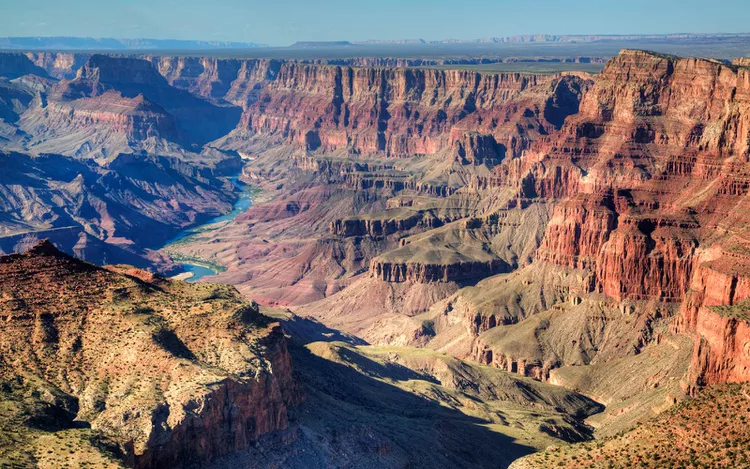1. Explore Arizona’s National Parks
2. Must-Visit Attractions
3. Unique Natural Phenomena
Get ready to explore the Grand Canyon — and much, much more.
Fact checked by Elizabeth MacLennan
Maybe the Grand Canyon is already on your list of must-sees in Arizona (for good reason), but it’s fair to say the state has a lot more to offer than its celebrity park: It’s home to 21 other National Park Service monuments, recreation areas, memorials, and historic sites.
If you’re planning a trip to Arizona and want to take a deep dive into some of the state’s treasured natural and historic attractions, here are the scenic spots that are well worth a visit.
Grand Canyon National Park

Open year-round, Grand Canyon National Park‘s South Rim has more lodging, restaurants, museums, and services, but its popular Grand Canyon Village can be packed in prime summer months. If you’re keen on encountering fewer people, consider visiting the North Rim between mid-May and mid-October. In either location, you’ll experience spectacular views of the world-famous canyon, carved by the Colorado River millions of years ago, which later became a sacred home to 11 Native American tribes.
It’s vital to stay hydrated and protected from the sun at the Grand Canyon, given its elevation of more than 7,000 feet. Interestingly, the canyon becomes significantly hotter as you descend, whether by foot or by mule. Therefore, dress in layers, bring plenty of water and snacks, and heed all safety advisories.
Saguaro National Park

Immerse yourself in the diverse ecosystems at Saguaro National Park, a location where John Wayne filmed his famous Westerns. This park features two sections on either side of Tucson: the Rincon Mountain District to the east and the Tucson Mountain District to the west. The eastern district boasts 128 miles of hiking trails, while the western features 43 miles of scenic paths. Each side offers ample opportunities for stunning photographs with the iconic giant saguaro cacti — just remember to stay on the marked paths. Signal Hill on the west side is a hotspot for viewing petroglyphs (ancient rock carvings).
Petrified Forest National Park

Petrified Forest National Park captivates visitors with its striking rock formations and fossilized logs dating back over 200 million years. While driving through the park allows for quick stops at overlooks, taking short walking trails offers a more immersive experience, revealing key sights such as the Painted Desert and ancient pueblo remains. Additionally, a lesser-known adventure can be found at Devil’s Playground, where permit holders can explore unique hoodoos formed by clay soil erosion.
Montezuma Well at Montezuma Castle National Monument

Montezuma Castle, a remarkable 20-room dwelling carved into a limestone cliff around 1050 by the Sinagua people, provides profound insights into the region’s historical inhabitants. Just an 11-mile drive northeast of this site is Montezuma Well, a stunning sinkhole managed by the NPS that showcases over 1.5 million gallons of flowing water daily, remaining a constant 70 degrees, and supporting unique aquatic life, including a water scorpion. While swimming is not permitted (due to the water scorpion), visitors can enjoy a picnic area where they can dip their feet if desired.
Tuzigoot National Monument

If you’re intrigued by the history of the region, head northwest about 20 miles to explore Tuzigoot National Monument. Here, you can walk through a 110-room pueblo, offering a tactile connection to the Sinagua people’s past. The accompanying museum displays a variety of ceramics, textiles, and tools that were part of village life. A highlight is that the entrance fee covers both this site and Montezuma Castle.
Sunset Crater Volcano National Monument

Nearly 1,000 years ago, a volcano erupted violently northeast of Flagstaff, spreading ash and lava across 900 square miles. During your visit to Sunset Crater Volcano National Monument, you can walk the accessible Lava Flow Trail at the base of the volcano, known for its striking yellow and red cinder cone, to explore the fascinating geological features left behind by the eruption.
Casa Grande Ruins National Monument

Located an hour’s drive south of Phoenix is the Casa Grande Ruins National Monument, which safeguards a unique 650-year-old structure built by the Ancestral Sonoran Desert People. This monument serves as a historical testament, believed to have been a gathering place or way station and is currently home to a variety of local wildlife, including great horned owls and bats. Notably, entry to this national monument is free.
Tumacácori National Historical Park

Dedicate time to visit Tumacácori National Historical Park, where the ruins of a significant mission complex from the Spanish colonial era are preserved. This park encapsulates a history of co-existence and conflict between Jesuit and Franciscan missionaries and the indigenous O’odham people. The well-curated museum offers artifacts that narrate the rich history of the Santa Cruz Valley.
Organ Pipe Cactus National Monument

Experience the diverse ecosystem of cacti, flora, fauna, and stunning western landscapes at Organ Pipe Cactus National Monument. Located on the southern border of the USA, this park is worth the journey for outdoor enthusiasts. Participate in the monument’s “Hike for Health” challenge, enjoying the trails while collecting a souvenir coin as a reward.





